Friend or Foe?
The definition of a weed is any plant that is growing where it is not wanted. In other words, a particular species may be classified as a nuisance by one person while another considers it to be a valuable plant. For example, corn is grown on over 80 million acres in the United States, is the source of billions of dollars in income for farmers, and serves as food for millions of people and animals. However, if a corn plant is growing on the fairway of a golf course, then it is, by definition, a weed.
In Nevada, perhaps no plant causes feelings of division about its worth as much as Russian-olive (Elaeagnus angustifolia L). Some land managers and residents view Russian-olive as a critical component of arid landscapes. Others curse it as a dreaded weed. Russian-olive thrives under the extreme environmental conditions (e.g., temperature, moisture, soils) of Nevada and has been widely adopted as a hardy tree for landscapes and windbreaks. However, Russian-olive has also demonstrated the ability to escape cultivation and become a difficult-to-control weed. The weedy characteristics of Russian-olive have led Colorado, New Mexico, and five Utah counties to declare the species as a noxious weed; meaning, it is illegal for a property owner to allow the plant to grow within those states or counties.
At this time, the Nevada Department of Agriculture does not plan to list Russian-olive as a noxious weed. The weedy nature of this species, however, often raises questions about its control. This publication provides information about the identification, biology, and control of Russian-olive so land managers and residents can make management decisions about this species.
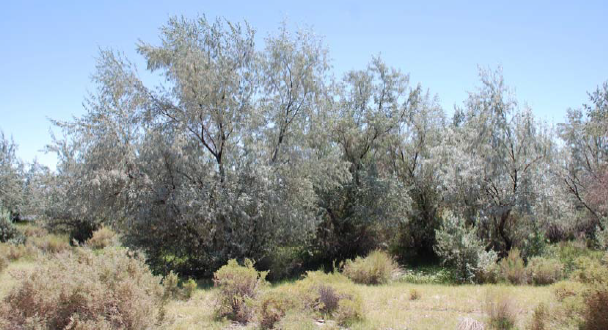
Russian-olive has been a popular windbreak tree and landscape ornamental throughout the West, but the species frequently escapes cultivation and infests riparian areas. Photo: Earl Creech.
Origin and Distribution
Russian-olive is native to eastern Europe and western Asia. The species arrived in the United States during colonial times and moved west with the early settlers. By the early 1900’s, Russian-olive was present in most western states. The first known planting of Russian-olive in Nevada occurred in 1906. Russian-olive’s ability to thrive in arid environments has led to its widespread use for windbreaks and ornamental plantings throughout the West.
Soon after its introduction, Russianolive began to escape cultivation and become weedy. The species is particularly suited to invade seasonally wet riparian habitats. In such areas, Russian-olive is highly competitive and can displace native vegetation, such as willows and cottonwoods. The fruit of Russian-olive can be used for food, but wildlife generally prefers to use native vegetation. Russian-olive branches often bear thorns that can interfere with the movement of humans, livestock, and wildlife. Growth of the species along the banks of waterways can restrict water flow and increase soil erosion.
Identification
General
Fast-growing, deciduous shrub or small tree that usually reaches 10 to 25 feet in height. Russian-olive forms a dense thicket when a number of plants are growing close together.
Leaves
Arranged alternately, 2 to 3 inches in length, and lanceolate with smooth margins. The upper leaf surface is green-gray while the lower surface and leaf stalks are silvery gray. Foliage has an overall silvery appearance from tiny scales that cover the leaves.
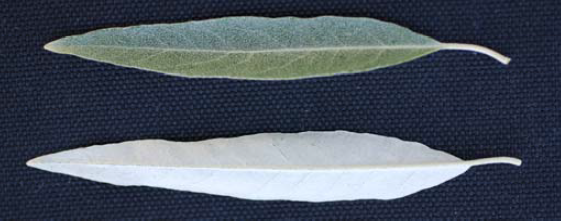
The leaves of Russian-olive are lanceolate with a green-gray upper leaf surface (top) and a silverygray lower leaf surface (bottom). Photo: Earl Creech.
Branches
Dark reddish-brown in color and usually have 1- to 2-inch woody thorns. Similar to the leaves, twigs are covered with scales that give a silvery-gray appearance.
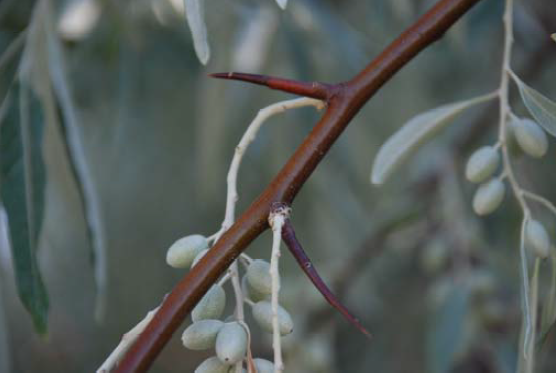
Branches of Russian-olive are dark reddish-brown in color and usually have 1- to 2- inch woody thorns. Photo: Earl Creech.
Flowers
Usually appear between May and June, and are yellow, bell-shaped, and arranged in clusters.
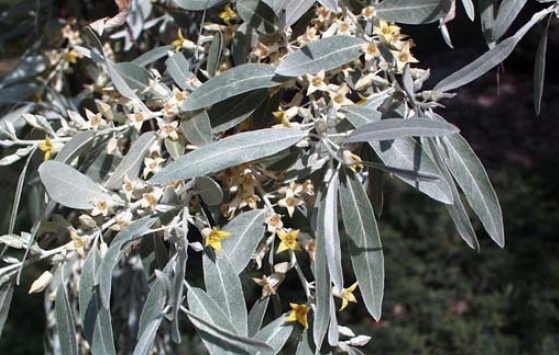
The yellow flowers of Russian-olive appear in the spring and occur in clusters. Photo: Paul Wray, Iowa State University, Bugwood.
Fruits
Shaped like small olives and contain a single seed. Newly-formed fruits are silver but become tan or brown as they mature.
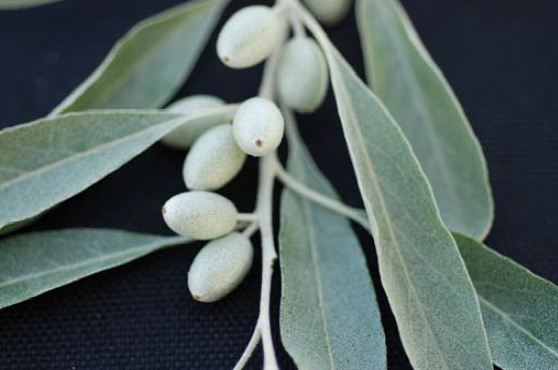
The fruits of Russian-olive have the appearance of small, silver-to-brown colored olives. Photo: Earl Creech.
Roots
Deep and well developed. Regrowth from crown or underground lateral roots is common in cut trees.
Similar species
Russian-olive can be confused with some species of willow (Salix spp.) but is easily distinguished by its flowers and seeds. Willows produce small, inconspicuous flowers borne on erect stalks. Russian-olive has large, yellow, bell-shaped flowers. The seed of willow is attached to a white, cottony pappus that facilitates wind dispersal. Russian-olive seeds are encased in the olive-like fruit. Russian-olive is sometimes confused with silver buffaloberry (Shepherdia argentea) but the two species have different leaf arrangements. The leaves of silver buffaloberry are opposite one another. Also, the fruit is a small red-orange berry. Russian-olive leaves have an alternate arrangement. The berries are silver-to-brown colored.
Biology
Russian-olive thrives under a wide range of soil and moisture conditions. The plant readily survives periodic flooding and is drought tolerant. Russian-olive grows in many types of soil (e.g., sandy, silty, loamy), including sites with low fertility and high salinity.
Russian-olive can form new plants from vegetative structures but seed produces the majority of new plants. Birds and other animals consume the fruit and transport the seed to other areas.
Control
Once established, control of Russian olive is difficult. Live seeds persist in the soil for many years and disturbed plants can regrow from lateral roots and other plant parts. The most effective and least expensive control tactic is to prevent establishment of the first plant. Not using Russian-olive as a landscape or ornamental tree prevents if from escaping into adjacent areas where it is not wanted. When new infestations of Russian-olive emerge, immediate application of control measures usually eradicates the stand before it can develop an extensive root system and persistent seed bank.
Several management practices are effective for controlling established stands of Russian-olive. Saplings can be trimmed with a tractor-mounted mower, but must be repeated regularly. Mowing is a relatively simple operation and the results occur quickly. For large trees, top-growth can be removed with a chain saw. Russian-olive can regrow from cut stumps, twigs or branches. Cut material must be removed and destroyed. New sprouts that emerge from the cut stump or lateral roots should be pruned regularly.
A number of herbicides and application techniques can be used to control Russian-olive. Cut-stump applications (herbicide applied to the stumps surface immediately after removing top-growth) are often successful. Effective herbicides contain tryclopyr ester (Remedy®, Garlon® 4), triclopyr (Garlon® 3A), or imazapyr (Arsenal®, Habitat®). Triclopyr ester or 2,4-D + triclopyr (Crossbow®) can be applied as basal-bark treatments (herbicide applications made directly to the lower 2 feet of an uncut Russian-olive trunk). Finally, foliar applications of 2,4-D, glyphosate (Rodeo®, Roundup®, others), triclopyr ester, 2,4-D + triclopyr, or imazapyr to fully expanded leaves can succeed if applied two to three times per year. Rodeo® and Habitat® are the only products that are both effective on Russian-olive and labeled for use in or around water.
Once mature plants are controlled, competition from desired plants is needed to suppress the re-establishment of Russian olive. Establishing native plants, such as willow and cottonwood, can reduce the resources (i.e., light, water, and nutrients) available to Russian-olive and, thereby, suppress its establishment. Perennial understory species are also important competitors with new Russian-olive seedlings. Failure to establish adequate desirable vegetation allows Russian-olive and other weeds to rapidly re-invade the site.
No single control method or one-pass effort will successfully eliminate Russian olive. The use of two or more control methods (integrated weed management) for several years is necessary. Permanent control will require many years of monitoring and treatment until the persistent seed bank has been exhausted and all buds on the root system have been completely killed.
References
- Dewey, S. A., S. F. Enloe, F. D. Menalled, S. D. Miller, R. E. Whitesides, and L. Johnson. 2006. Weed Management Handbook 2006-2007. Montana, Utah, and Wyoming Cooperative Extension. 267 pp.
- DiTomaso, J. M., and E. A. Healy. 2007. Weeds of California and Other Western States. University of California Division of Agriculture and Natural Resources. Pub. 3488. 1:689-692.
- Stannard, M., D. Ogle, L. Holzworth, J. Scianna, and E. Sunleaf. 2002. History, biology, ecology, suppression and revegetation of Russian-olive sites. Technical Notes: USDA-NRCS. Plant Materials No. 47.
- Whitson, T. D., L. C. Burrill, S. A. Dewey, D. W. Cudney, B. E. Nelson, R. D. Lee, and R. Parker. 2006. Weeds of the West. 9th edition. Western Society of Weed Science: Las Cruces, NM.
- William, R. D., D. Ball, R. Parker, J. P. Yenish, T. W. Miller, D. W. Morishita, and P. J. S. Hutchinson. 2006. Pacific Northwest Weed Management Handbook. Oregon State University. 428 pp.
Creech, E. and Rafferty, D.
2007,
Identification and Management of Russian-Olive,
Extension | University of Nevada, Reno, FS-07-39


